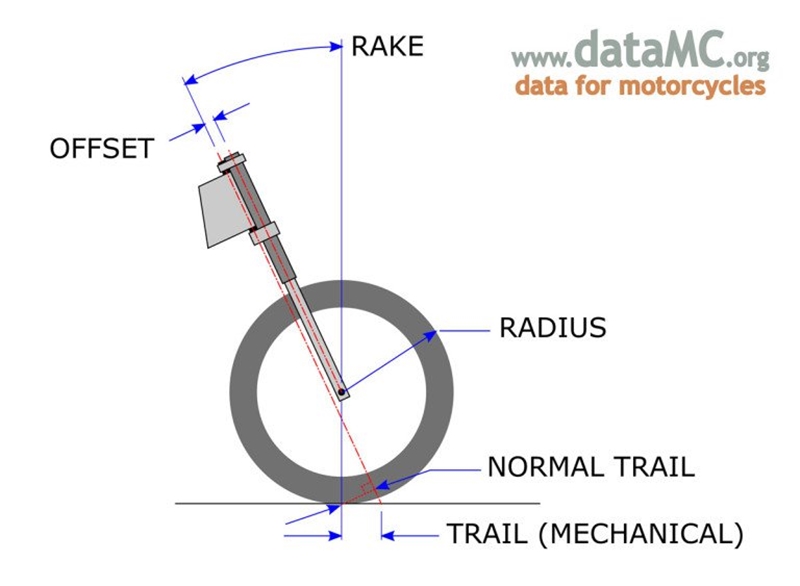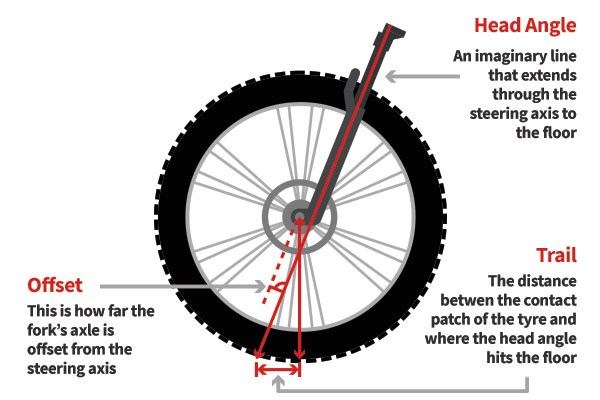MegaSack DRAW - 6pm Christmas Eve - LIVE on our YouTube Channel
Is head angle just the head tube, or does it take the fork rake/trail into account?
Trying to compare two very slightly different frames, but don't know figures for the forks, am hoping forks are both same offset...
yes - change the fork offset alone and the HTA will move a fraction but not in a way that's worth considering in a comparison like that
Offset does not change the steering head angle at all apart unless the fork is also longer or shorter. Its simply the angle of the headtube
For some weird reason in the bicycle world rake is often used to describe offset
Yep, I'm guilty even in the post above of confusing rake and offset!
It's all good, have found the missing piece of the puzzle, both forks have identical offset and axle-crown, so I just need to compare head tube angles.
Now, should I make a framebuilder's life a misery and ask him to split the difference between a 70.5 degree head angle and 71 degree HA. 70.75 degrees? 😁
I strongly doubt their tolerances will be tight enough to pull that off.
That would have been my next question, wonder what difference in head angle is even noticeable!
Welcome to the wonderful world of trail - which is what you get due to a combination of fork offset and head tube angle. Worth checking what the normal trail is for the kind of bike and then work back from the fork offset rather than just looking at the HTA. I've often started a frame design from the basis of the fork than being driven by the current HTA 'fashion'. I've specc'd custom frames down to half-degree angles.
https://www.bikeexchange.com/blog/bike-geometry-charts
I have only ever heard fork offset and rake used interchangeably, but @13th's post above suggests there is a difference. ???
I have only ever heard fork offset and rake used interchangeably
Yes it is the same thing. The difference between a straight line down from the steerer and the middle of the dropout
Now, should I make a framebuilder’s life a misery and ask him to split the difference between a 70.5 degree head angle and 71 degree HA. 70.75 degrees? 😁
That's what you do when you can't decide between one or the other, not because you can feel the difference. You can then convince yourself later it's either so you never have to make the decision : )
Yes it is the same thing. The difference between a straight line down from the steerer and the middle of the dropout
I don't think it is, if you take it to extremes.
Imagine a 70* head angle but 500mm of trail - the wheel would 'load up' in corners and the handlebars would rotate 'normally'.
Imagine a 30* head angle and straight forks - the wheel would feel lighter and the handlebars rotate in a different plane, almost up and down as much as left to right.
Splitting hairs time though over a few mm and half a degree... A change of front tyre would do the same.
Rake is the head tube angle. fork offset is sometimes in the bicycle world referred to as rake which causes confusion.

Rake is the head tube angle.
Given that we're on a bicycle forum, I'd say that was wrong. If we were on a motorcycle forum then I'd agree. Rake in motorcycles is also measured in a different way from the equivalent head-angle on bicycles. Your example image above illustrates this. That would be a rake of somewhere in the region of 30º which would be even more confusing if used in the bicycle world. Bicycles use the supplementary angle in this case of 60º. I also think they have the description of the two types of trail confused. Mechanical trail is always a perpendicular distance from the ground to the steering axis, not how it's shown on that diagram.
“ Given that we’re on a bicycle forum, I’d say that was wrong. If we were on a motorcycle forum then I’d agree. Rake in motorcycles is also measured in a different way from the equivalent head-angle on bicycles.”
Exactly this. Bicycles predate motorbikes. Bicycles use head angles quoted so they’re in the 60-75 deg range (from horizontal) rather than 15-30 deg from vertical. Rake is offset on bicycles. Rake is head angle on motorbikes. These are the conventions for two different vehicles.
Yeah sorry folks, I was being lazy and used the two terms in the same post. I knew what I meant at least!
Crux of my problem is that I'm riding a frame one size too small, as evident from 75mm of headset spacers, 110mm stem AND 20mm rise bars...
This means the bike has a relatively short wheelbase for the style of bike and size I *should* be riding. Combined with the 71d head angle I think this is why the bike is so lively in corners, the handling is fantastic!
If I went custom I'd want to retain handling whilst dropping BB 10mm, lengthening head tube 20mm, and also increasing reach 10mm. Feels like I'd need to accept a slight increase in wheelbase and subsequent very minor slowing down of handling...
No idea why motorbike terms are being used for bikes.
Now, should I make a framebuilder’s life a misery and ask him to split the difference between a 70.5 degree head angle and 71 degree HA. 70.75 degrees?
Ignore the usual pedants on here. Instead, ask your framebuilder for a proper head angle 😁
If I went custom I’d want to retain handling whilst dropping BB 10mm, lengthening head tube 20mm, and also increasing reach 10mm.
That's not going to happen.
If I went custom I’d want to retain handling whilst dropping BB 10mm, lengthening head tube 20mm, and also increasing reach 10mm. Feels like I’d need to accept a slight increase in wheelbase and subsequent very minor slowing down of handling…
If the head angle remains the same if would feel similar.
- If you are currently riding with 75mm of spacers in theory you could just have a head tube 75mm longer and handling would be exactly the same so increasing head tube length won't affect anything and the steering will feel the same
- If you drop BB 10mm you will notice it but not massively and the bike would probably feel slightly better as feeling more sat in the bike rather than on the bike.
- If you increase reach and use a shorter stem the steering will feel different as will the handling due to longer wheelbase but again 10mm is not very much
And ultimately the changes you are suggesting are all very minor and the outcome would be 30mm less spacers (longer headtube + lower BB) and and a 100mm stem (so still long)
I wouldn't spend the money on a custom frame for such minor differences.
Rake is an angle ie the headtube angle. Offset is a distance measurement
it make no sense to misue the word rake for offset. It makes no sense in linguistic terms or geometry. rake is an angle - thats what the word means
Its not just motorcycles using the words this way. Many bike manufacturers do
As can be seen from this thread it just causes confusion
this is from Fox the suspension manufacturer

...but still "head angle" not "rake angle", according to Fox.
Those of us not steeped in motorbikes (ie the vast majority) have been using this lingo for decades and know no other.
To suggest it's "wrong" and we should all do what you think is not going to work (and a bit arrogant, sorry).
rake noun (2)
Definition of rake (Entry 3 of 5)
1 : inclination from the perpendicular especially : the overhang of a ship's bow or stern
2 : inclination from the horizontal : slope
3 : the angle between the top cutting surface of a tool and a plane perpendicular to the surface of the work
You measure an angle in degrees. If you are measuring it in distance its not rake.
I know there is a lot of confusion in the cycle world over this - its not as tho rake is used universally to mean offset.
its not as tho rake is used universally to mean offset
In my experience it is, in the bike world. No confusion for me until this thread.
Feels like I’d need to accept a slight increase in wheelbase and subsequent very minor slowing down of handling…
The longer bike might feel a bit different on a flat trail to begin with but I doubt it'd take more than a few miles/hours etc to get fully used to that. As you say, it's minor.
I don't believe wheelbase affects handling 'speed' or cornering as much as some suggest/think. It will do on a road bike where the tyres grip 100% of the time but when off-road the tyre/s can drift a bit and good overall geometry and weight distribution can mean a bike with longer wheelbase being faster through corners than a shorter wheelbase that has made compromises to do so. Grip, confidence in the front and weight balance is way more important than wheelbase. Plus, few of us really have the skills to push a bike hard enough that 25-50mm of wheelbase will hold us back there.
PS one answer, rake is a term we don't need as it always comes up for debate. There's HTA, fork offset and trail. Easy.
Premier Icon
jameso
Full MemberPS easy answer, rake is a term we don’t need as it always comes up for debate. There’s HTA, fork offset and trail. Easy.
My understanding is that “rake”, meaning offset, stems from bicycles having at one time curved fork legs, which could be described that way, I suppose.
it make no sense to misue the word rake for offset. It makes no sense in linguistic terms or geometry. rake is an angle – thats what the word means
You need to tell the fork manufacturers (mainly road forks) that still give a rake measurement in mm, 34mm, 45mm etc,. to this day.
Anyone involved in cycling for many years knows that rake is the same as offset in the cycling world (rightly or wrongly) so not really a big deal is it.
Yes. I wonder what it has to do with the garden implement, or a raffish gentleman.
My understanding is that “rake”, meaning offset, stems from bicycles having at one time curved fork legs, which could be described that way, I suppose.
Maybe? I just see rake as a vague term, particularly with its use in motorbikes, vs offset being accurate - the axle's offset from the steering axis.
head angle is not independent of fork rake in terms of steering feel.
but a half degree difference is nearly nothing. The measurement that matters is the trail value measured perpendicular to the steering axis. This is the measurement you should be comparing for how heavy the steering feels. Be aware that this also controls how tightly you can turn. Contrary to what is said in the mags a larger trail'd bike WILL turn faster than a low trail one as you can lean more for the same radius of turn.
But honestly get the trail figure right and the weight balance between the wheels and ignore the numbers which get you there. The rest is fluff.
For your delectation here's a project with a vertical headtube and reverse rake fork.


